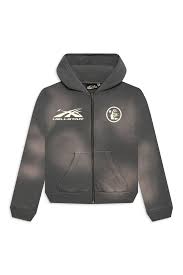How to Tell the Difference Between Common Streetwear Brands Featuring Hellstar
Streetwear has evolved into a diverse and influential fashion movement. With so many brands entering the scene, it can be challenging to distinguish between them. This guide focuses on how to identify and appreciate the key differences between notable streetwear brands, with a spotlight on Hellstar, a rising star in 2024’s fashion scene.
1. Hellstar: The Edgy Newcomer
- Origin and Rise: Hellstar is one of the most buzzworthy brands of 2024, known for its dark, futuristic aesthetic and bold statements. Rooted in avant-garde streetwear, it appeals to trendsetters looking for cutting-edge style.
- Signature Style: Graphic-heavy designs, premium materials, and a vibe that merges streetwear with high fashion. Pieces often feature dystopian themes, bold logos, and intricate detailing.
- Target Market: Hellstar appeals to younger audiences who seek individuality and exclusivity in their wardrobe.
2. Supreme: The OG Hype Beast Favorite
- What Sets It Apart: Supreme is the cornerstone of streetwear. Known for its iconic red box logo, the brand prioritizes exclusivity through limited drops.
- Style Notes: Minimalistic yet bold designs, heavy collaborations (e.g., Nike, The North Face, Louis Vuitton).
- Comparison with Hellstar: While Supreme leans on hype and skate culture, Hellstar thrives on artistic storytelling and futuristic vibes.
3. Off-White: Streetwear Meets Luxury
- Defining Features: Founded by the late Virgil Abloh, Off-White blends high fashion with streetwear. Its designs often incorporate quotation marks, arrows, and industrial straps.
- Why It’s Different: Off-White commands a luxury price point, targeting those who want streetwear with a designer edge.
- Comparison with Hellstar: Off-White maintains a polished, global appeal, while Hellstar caters to niche audiences craving edgier, underground looks.
4. Fear of God: Elevated Basics
- What It Offers: Founded by Jerry Lorenzo, Fear of God specializes in neutral tones, oversized fits, and high-end materials.
- Key Difference: Fear of God embodies minimalism, while Hellstar’s identity revolves around statement pieces and bold designs.
5. Stüssy: The Pioneering Brand
- Historical Relevance: Founded in the 1980s, Stüssy is considered one of the originators of streetwear.
- Aesthetic: Surf/skate culture-inspired graphics, casual silhouettes, and timeless appeal.
- Comparison with Hellstar: Stüssy is a staple for laid-back streetwear, while Hellstar pushes boundaries with futuristic and intense designs.
Tips for Identifying Authentic Streetwear
- Inspect Labels and Tags: Hellstar, like other premium brands, includes high-quality stitching and unique branding that counterfeit items often lack.
- Examine Packaging: Brands like Hellstar invest in high-end packaging, adding to the overall experience.
- Know the Trends: Stay updated on the latest drops by following reputable sources and checking resale platforms like StockX or Grailed.
Where to Buy and Sell Hellstar in NYC
Looking to sell your Hellstar pieces or other premium streetwear? East Village Buyers at 39 Avenue A is the top destination in NYC. We specialize in buying authentic streetwear and ensure you get a fair price for your items.
- What We Buy: Hellstar, Supreme, Off-White, BAPE, and more.
- Why Choose Us: Our expertise in assessing streetwear ensures that you’ll always get the value your pieces deserve.
Visit our store today or follow us on Instagram to stay updated on what we’re buying.
Streetwear is more than just clothing—it’s a culture. Whether you’re buying or selling, understanding the unique characteristics of each brand helps you appreciate their artistry and value. At East Village Buyers, we make it easy to stay ahead of the game.
